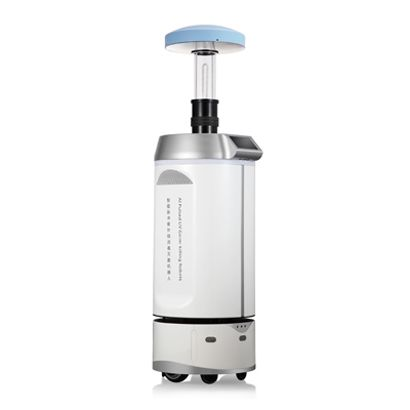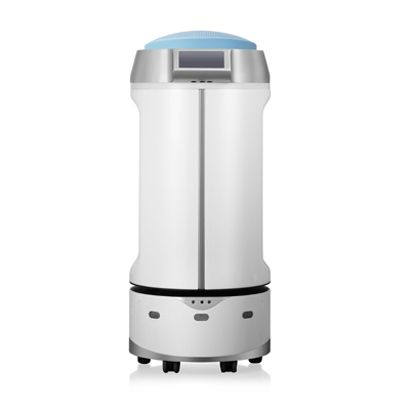Why pulsed light disinfection sheets robot is better than Lamp?
2022-04-29 by hqt
Pulsed light disinfection sheets robot effectively disinfects surfaces in shortest possible time. Thanks to its AlStrike technology, we can use it to destroy microbiological threats, including:
- Bacteria
- Viruses
- fungi and their spores, mycobacteria or spore forms
Even the seemingly cleanest room, when looked at under a microscope, is full of small pollutants, and above all, microorganisms. Bacteria, viruses and fungi and their spores are everywhere in our environment, whether we like it or not.
UV radiation - an effective method of disinfection
Ultraviolet UV radiation is part of the solar spectrum, invisible to humans, but felt by organisms.
There are three wavelengths of UV:
- UV-A is a wavelength of 315-380 nm;
- UV-B is a wavelength of 280-315 nm;
- UV-C is a wavelength of 100-280 nm.
Simple washing or even disinfecting the surface will not ensure 100% cleanliness. There are methods that allow for thorough air and surface disinfection, and the accessories used for this are, for example, UV disinfection lamps.
UV robots for disinfection are best suited for disinfecting air and surfaces. To achieve full effectiveness, follow the manufacturer's recommendations regarding the working and best place to install. Generally, we use pulsed light disinfection sheets robot in hospitals and areas where there is massive threat of viruses. These robots can kill a vast number of germs present on hospital and clinic’s surfaces.
What is UV-c disinfection?
Ultraviolet (UV) radiation is divided into three ranges: UV-A (wavelength 400-315 nm), UV-B (wavelength 315-280 nm) and UV-C (wavelength 280-100 nm) - the latter is harmful for living organisms. The range from 230 to 275 nm is bactericidal as this radiation is absorbed by nucleic acids and proteins, damaging the DNA and RNA chains.
Where to use pulsed light disinfection sheets robot?
During the COVID pandemic, pulsed light disinfection sheets robot was quite popular among medical and pharmaceutical facilities, as well as in processing and industry requiring sterile conditions. Currently, the scope of use is much wider. Such devices will find a place wherever microbiological cleanliness is important.
In addition to the aforementioned medical facilities, they will also include:
- commercial centers
- offices
- service premises
- fitness and beauty sectors
- Education
- hotel and tourism
- Entertainment
- public transported many others
A disinfection robot will work there. Disinfecting rooms and surfaces will protect employees, customers and visitors against the risk of infection by viruses and bacteria transmitted by droplets. Similarly, it will also ensure microbiological cleanliness of surfaces and objects subjected to irradiation.
Different Types of UV Disinfection Robots
Our company offers 2 major Types of Disinfection Robots:
- Pulsed Xenon UV Germ-killing Robots Aistrike
- Pulsed Xenon UV Germ-killing Robots Pulsein-D
Thanks to the use of appropriate swift disinfection technology, pulsed light disinfection sheets robot remove microorganisms and other solid contaminants easily.
These robots offer direct disinfection. Moreover, these are best to disinfect surfaces, objects, floors and other elements that are directly exposed to light. The condition for effective disinfection is that the disinfected surface must be exposed to the lamp and disinfected for a strictly defined time, which depends on the type of microorganisms.
Pulsed Light Disinfection Robot disinfection and coronavirus
UV-C radiation disinfection is a recommended method of disinfecting rooms and surfaces also in the case of coronavirus. Pulsed light disinfection sheets robot deactivates and eliminates the vast majority of viruses in just a few seconds.
Furthermore, its operation is quite simple. There is no manual intervention and these robots works freely. We can say that their performance is far better than uv lamps and manual disinfection methods.
Every day our body comes into contact with pathogenic microorganisms. And while the body's natural defenses deal with many of them. It is not always possible to guard against disease. Recently - apart from the well-known infections and diseases - the world has to fight the COVID-19 pandemic.
How to protect yourself from the coronavirus, what virus protection measures should you be aware of?
Man versus virus
We are exposed to microbes from the first day of life. Contact with sick people, touching contaminated everyday objects - this is the most common way that viruses and bacteria have to go through in order to get to another person.
Here, protective barriers await them, such as the skin or nose, which cleans the inhaled air in the amount of 6-7 liters per minute. Protecting against viruses, whether they manage to survive and cause inflammation, also depends a lot on the immune system.
What can you do to improve your immunity and strengthen your protective barriers? It is definitely worth focusing on sufficiently long sleep, regeneration, as well as physical activity adjusted to age and needs. In addition, a healthy diet, rich in vegetables and fruits, avoiding stimulants and regular checkups with a doctor is important.
How to avoid viruses and diseases?
Hydration of the body and taking care of the intestines are also important. Here it is worth focusing on silage as a healthier and better alternative to dietary supplements. In order to ensure the proper functioning of the respiratory tract, it is necessary to take care of the nasal mucosa.
This unfortunately dries the air in rooms with too low humidity. The recommended protection against coronavirus is also social distance, proper hygiene (frequent washing of hands and avoiding touching the face) and vaccination. Virus protection measures close the list and more, more specifically skin and surface disinfectants, gloves, visors and protective coveralls used by medical services.
The best protection against all these diseases is to use pulsed light disinfection sheets robot. Moreover, you cannot forget about protective masks, especially the most effective of them FFP2 and FFP3, which limit the spread of viruses.
Protection against viruses - disinfection and protective gloves
Skin and surface disinfection is a proven method to minimize the amount of microorganisms in the environment. Protective measures such as spray, liquid or disinfecting gel should be in the first aid kit in every home.
It is worth remembering that most viruses and bacteria are found not on the toilet seat, but on everyday objects such as a telephone, keys, door handles, handrails and light switches. Pulsed light disinfection sheets robot is best to disinfect both medical and private surfaces.



